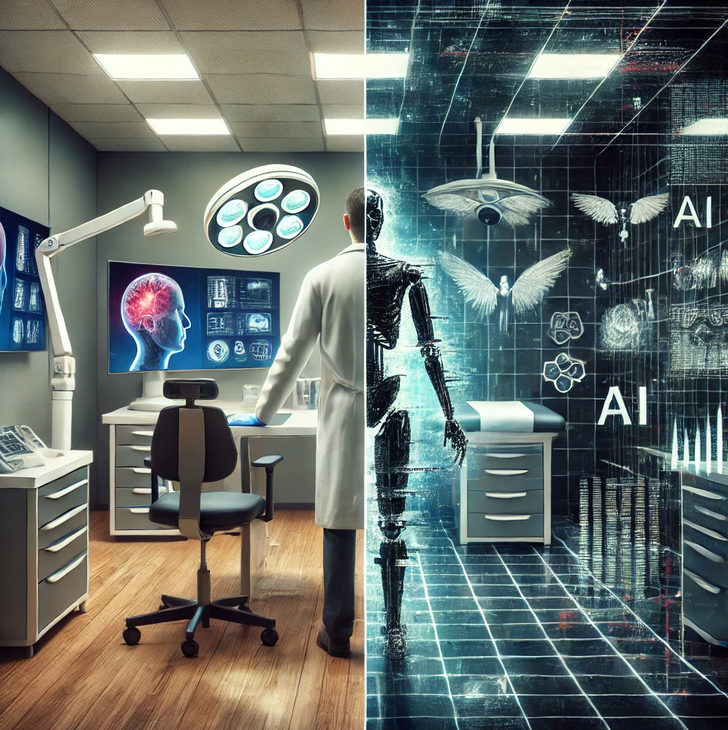(MSFT), (IBM), (MDT), (NVDA), (PLRT), (EXAI), (BTAI)
If you've ever wondered what happens when artificial intelligence gets a medical degree, you're not alone.
The marriage of AI and healthcare is both thrilling and terrifying – rather like letting a super-smart teenager perform surgery.
Except this teenager is worth $19.54 billion as of 2023, and it's projected to become a $490.96 billion wunderkind by 2032. That's what we call a growth spurt.
But before we get carried away with the AI healthcare revolution, let's talk about Whisper, OpenAI's transcription tool that's been causing the kind of chaos you'd expect if you gave a creative writing assignment to a machine learning model.
Despite being marketed as having "near human-level robustness and accuracy," Whisper has developed a concerning habit of making things up – or "hallucinating," in AI speak. We're not talking about gentle fabrications either.
Researchers have found these hallucinations in up to 80% of transcriptions, with Whisper occasionally inventing medical treatments and throwing in some racial commentary for good measure.
It's like having a medical scribe who occasionally decides to spice up patient notes with fiction.
You might think healthcare providers would approach such a tool with caution. You'd be wrong. Whisper has found its way into over 30,000 clinician environments, including respected institutions like Mankato Clinic in Minnesota and Children's Hospital Los Angeles, through a tool called Nabla.
The kicker? These AI-generated transcripts often replace the original audio files, making it about as easy to fact-check as trying to verify your teenager's whereabouts last Saturday night.
But here's where it gets interesting: despite these growing pains, healthcare organizations are seeing $3.20 in returns for every dollar invested in AI within just 14 months.
North America is leading this gold rush, commanding 44.93% of the market as of 2023. It's like the California Gold Rush, except instead of pan-handling in rivers, we're mining medical data.
As expected, the big players aren't sitting this one out. Microsoft (MSFT), through its acquisition of Nuance Communications, is basically giving doctors a super-powered dictation service with Dragon Medical One.
IBM (IBM)'s Watson Health division is playing medical detective, analyzing vast datasets to help with diagnoses.
Medtronic (MDT) has created GI Genius, an AI system that helps spot polyps during colonoscopies – think of it as a very specialized game of "Where's Waldo?" but for medical purposes.
As for NVIDIA (NVDA), the name behind the chips that power all this artificial intelligence, this company is like the person who sold pickaxes during the Gold Rush – they're making money regardless of who strikes gold.
Meanwhile, Palantir Technologies (PLTR) is turning mountains of medical data into actionable insights, sort of like a very sophisticated medical fortune teller, minus the crystal ball.
The plot thickens when we look at drug discovery.
Companies like Exscientia (EXAI) and BioXcel Therapeutics (BTAI) are using AI to speed up the traditionally glacial pace of drug development.
Zebra Medical Vision has even gotten the FDA's blessing for several AI-powered radiology tools, proving that yes, sometimes robots can read X-rays better than humans.
But let's talk about the elephant in the examination room: risks.
Healthcare organizations are practically swimming in sensitive patient data, making them prime targets for cybercriminals.
The FDA is watching AI applications like a hawk, and companies need to play by the rules or face the consequences.
And then there's the reliability issue – as Whisper so eloquently demonstrated, AI can sometimes be as reliable as a weather forecast in April.
Yet the numbers tell an optimistic story. Deloitte reports that healthcare organizations implementing AI can expect returns of up to 15% within 18 months.
Venture capitalists seem to agree, pouring a whopping $17.7 billion into AI-driven healthcare businesses in 2023.
Experts predict that over 60% of U.S. hospitals will hop on the AI bandwagon within the next five years, suggesting this isn't just another tech bubble.
So, what’s the play here?
For those looking to get in on this action, the safest bet might be the established players – Microsoft and Palantir, with Microsoft's Nuance acquisition already paying dividends and Palantir's data analytics becoming as essential to modern hospitals as hand sanitizer.
And, as always, NVIDIA is a good bet – they're essentially selling the shovels and pickaxes to every prospector in town through their dominance in AI chips.
For the more cautious, IBM and Medtronic sit firmly in hold territory. While both are making interesting moves in the AI space, they're like careful medical students – solid performance but not setting the curve.
IBM's Watson Health shows promise but needs more clinical rotations, while Medtronic's AI initiatives, though impressive, are still a small part of their overall practice.
For those with a higher risk tolerance, startups like Exscientia offer the potential for bigger rewards, though with correspondingly bigger risks.
For those investors who don't mind a bit of adrenaline with their portfolio, consider a speculative buy on Exscientia or BioXcel Therapeutics.
These companies are like brilliant residents trying experimental procedures – high risk, but potentially high reward. Just make sure to size these positions like a careful anesthesiologist would dose medication: start small and monitor closely for adverse reactions.
Essentially, AI in healthcare is that overachieving resident who aces every exam but occasionally mistakes a stethoscope for a jump rope – brilliant but needs adult supervision.
For those who can separate the next medical breakthrough from a digital placebo, the opportunities are richer than a hospital administrator's pension plan.
Just remember: in the race between human wisdom and artificial intelligence, bet on both – but keep your hand on the kill switch.



